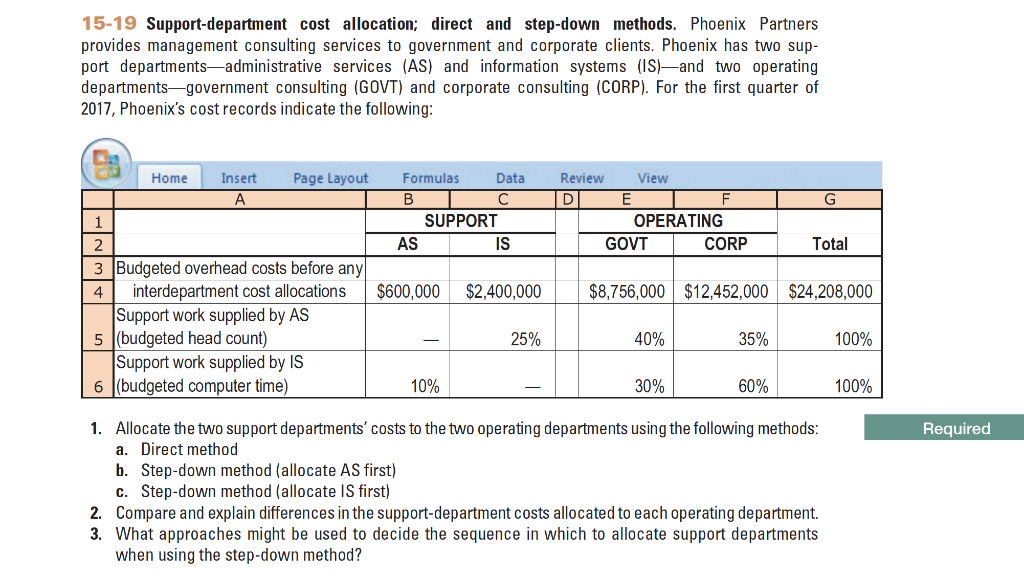
This allows for better decision-making when determining how much should be spent on different business areas. Now assume the Thurow Company cafeteria plans produces two products as indicated below. Describe the types of relationships between the departments within an organization.
The bottom line is this: precision drives profit
Costs are not allocated back to a department that has already had all of its costs allocated. The objective of this approach is to create equal gross profit percentages for all joint products. Advocates argue that any attempt to determine gross profit percentages forindividual joint products is useless for management decision purposes because the production or discontinuance of individual joint products are notalternatives. The average, or overall profit margin is the relevant measurement for the decision to produce or discontinue the joint process, i.e., produce allor none. However, critics of this method argue that since all joint products are not equally profitable, the joint cost allocation method should not imply thatthey are5. A counter argument is that all joint cost allocations arearbitrary in that the true profitability of individual products is indeterminable.

Understanding your operating costs
The allocations based on sales values at the split-off point (See Exhibit 6-17) are more acceptable from both the financial reporting and decision perspectives. The allocationscreate equal profit ratios for both products, which insures that the resulting inventory values for both products are below their market values.6This result will not create any special problems for accounting. From the management decision perspective, these results are not useful, but at least theydo not support an incorrect decision with regard to product D.
Types of Costs
Instead, we will allocate ALL of the services of each of these departments to the operating departments. You might opt for fixed cost allocation, where costs are split equally among departments regardless of size or activity. Any activity or factor that directly affects how much something costs your business. These can include labor-related costs, machine hours, distribution or admin costs, or anything else that causes a change in the costs of your business activity. This includes both direct and indirect expenses, as well as fixed or variable costs.
Get in Touch With a Financial Advisor
We are regularly updated – sign up with our newsletter to send the updates directly to your inbox. Katrina is a professional writer with experience in business and tech. She explains how data can work for business people without all the tech jargon. She is always on the look out for new ways data is being used by business people to know more and be sustainable. A financial professional will offer guidance based on the information provided and offer a no-obligation call to better understand your situation. Our writing and editorial staff are a team of experts holding advanced financial designations and have written for most major financial media publications.
AccountingTools
Can joint costs be allocated to joint products based on a “cause and effect” relationship? Notice from Exhibit 6-17 that using the physical quantities of chicken as an allocation basis results in an allocation to product D ($66,000) that exceeds the product’ssales value at the split-off point ($40,000). Of course this creates an inventory valuation problem from the financial reporting perspective asindicated above. In addition, these allocations have some rather senseless implications from the decision perspective, e.g., the company would be moreprofitable if it produced chickens with only breasts and wings. Note in this method, the human resources costs are allocated between custodial and all of the operational processes, while in the direct method, human resources and custodial are directly allocated to the operational processes. Custodial services on the other hand, may be better allocated based on the square footage of each of the operating departments.
The purpose of this method is to prevent the actualcost allocations to users from being influenced by the quantity of service consumed by other users. Allocating fixed and variable service costs using asingle actual rate can result in a variety of cost distortions. For example, situations arise where a user’s budgeted and actual consumption of a serviceare the same, but the actual service cost allocation to the user is greater than the budgeted allocation. In the second step, the equations for the service departments are solved first in the sequence established by the rules mentioned above.
Determine the difference in the total operating cost if electricity were purchased externally and indicate whether the company should make or buy electricity. Each of these equations includes two unknowns, thus determining S1 and S2 requires solving the equations simultaneously. Although simultaneous equations are notnormally solved by hand in practice, one method is presented in Exhibit 6-6 to illustrate the concept. Observe that the denominator for the proportion of service provided from S1 to S2 is 900, not 950. This is because the 50 KWH’s of self service are ignored in thestep-down method.
- The step-down method starts by identifying the primary cost center, often the one with no services received from other centers.
- For example, suppose you’re using a full absorption costing (FAC) system and another department within your company is using a direct labor cost system.
- Distribution can track the costs of delivering goods in full and on time.
- Of course this creates an inventory valuation problem from the financial reporting perspective asindicated above.
- Allocating indirect expenses is also important for decision-making purposes.
Manual data gathering is slow, error-prone, and can leave you making decisions based on last month’s reality rather than today’s situation. Square footage cost allocation works well for property-related expenses. Departments occupying a larger square footage of office space pay a larger share of rent and building maintenance costs. Activity-based costing is like dividing that restaurant bill according to who ate what.
Recall from the example that thereare two producing departments, Cutting and Assembly. Although each product passes through both departments, the products do not consume the departmentresources in the same proportions. As indicated in Exhibit 6-14, X1 requires a larger proportion of cutting time, while X2 requires a larger proportion ofassembly time. The various functional areas within a manufacturing facility are usually separated into two types of departments. These include producing departments and service departments.Producing departments convert raw, or direct materials into finished products. Service departments provide support services to the other departments in theplant.
We would allocate maintenance to Administration, Operating Departments 1 and 2 using the machine hours for each department x the maintenance rate per machine hour (round final answer to nearest dollar). Examples would be charging departments a “rental fee” for their use of vehicles from the motor pool, or for their use of a corporate conference facility. The biggest advantage of the step-down method is that it makes it clear that some departments, which otherwise might not be seen as doing so, make significant contributions to the business.

